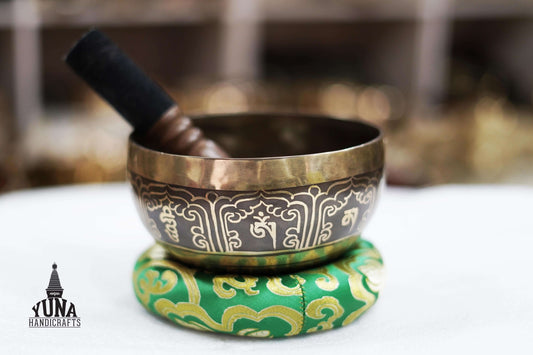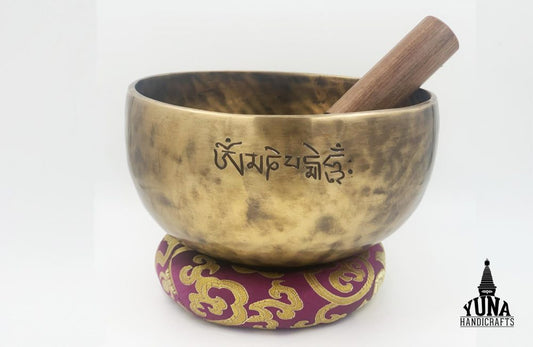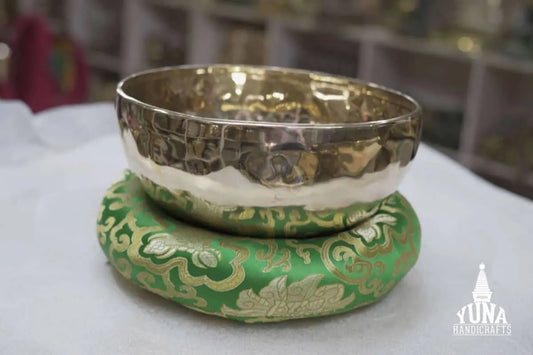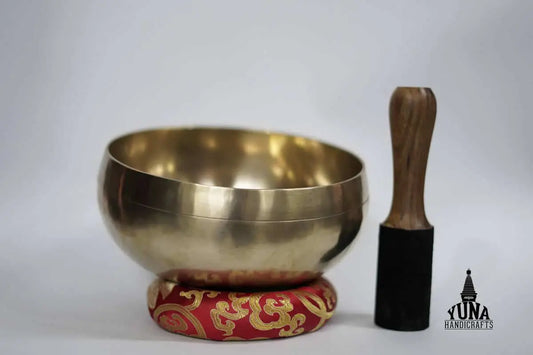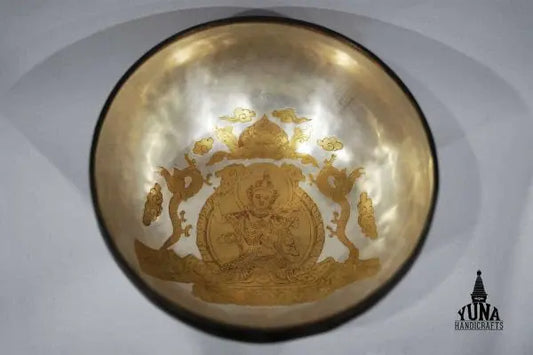
9 Types of Tibetan Singing Bowl and Their Unique Feature
9 Types of Tibetan Singing Bowl and Their Unique Feature
The Tibetan Singing Bowl is one of the well-known Buddhist ritual items. It’s also known as the “Himalayan” Singing Bowl. It’s in a bowl shape. The singing bowl is a traditional musical instrument of Buddhism that creates an auspicious sound or vibration. The vibration and sound are formed by friction. The sound is produced by hitting the corner of the bowl with a mallet and rubbing the bowl at a certain moment.
It’s mostly made of brass, zinc, iron, and copper, and the mallet is made of wood wrapped in a soft cloth. This singing bowl is used in spiritual practice and in a Buddhist ceremony. Many monks and lamas used this singing bowl while meditating and chanting mantras. It’s also used in therapy and for relaxation, and for many purposes. It’s believed that the sound produced by a singing bowl helps to purify the negative energy.
There are different singing bowls you can find. Their shape and size can be different. Each bowl has various tones & sounds, and each bowl is used for different purposes.
Jambati Singing Bowl
Jambati Bowl is one of the types of Singing bowls. This bowl was founded back in the 18th Century. The majority of Buddhist people used this bowl to store grain. This bowl is heavy and one of the simple singing bowls. The Jamabati bowl is hand-beaten. It’s designed in a U-curved shape and has a thick rim. It can be used in a healing treatment, including chakra balance and sound bathing. It can emit a very low, long-lasting tone.
Unique Features
-
Vocals range up to 4 octaves.
-
Weight approx. 1.65kg.
-
Used for storing grains, Chakra balancing, sound bathing, meditation, etc.
Thadobati Singing Bowl
The term “thado” means“Straight.” Thadobati has unique features because its surface is smooth and flat. The singing bowl of Thadobati has straight walls and a large flat base. The medium-sized bowls are made of a plain rim whose width is equal to the wall itself. This bowl carries positive vibes and energy. Compared to the jambati singing bowl, it’s deeper. It’s one of the ancient singing bowls in the market.
Unique Features
-
Weight up to 800gm to 800gm.
-
Vocals range up to 5 octaves.
-
Used for chakra healing, relaxation, Meditation, Yoga, etc.
Ultabati Singing Bowl
The Ultabati bowl is characterized by the fact that the bowl’s side is bent below the rim. These bowls are not very popular and are hard to find in a better tone quality. The remaining part is rugged with hammer marks. The bowl is lightly brushed inside, and the lower side of the collar is blackened or mottled.
Sometimes they are used to store grain. Ultabati is also used in ceremonies, musical feasts, and ritual usage. The bowls of Ultabati have the same low tones as the Jambati ones.
Unique Features
-
Weight is approx 1.1kg. Vocal range up to 2 and 3 octaves.
-
Used for meditation, musical purposes, grain storage, etc.
Remuna Singing Bowl
It is renowned for its lightness, strong sounds, and long vibrations. The shape and timbre of the Remuna singing bowl are similar to Thadobati. Remuna has sloping walls inwards. A different distinction is that Remuna is thinner than Thadobati. They are very popular for sound healing, meditation, and yoga because of their lightness and heavy tones.
Unique Features
-
Vocals ranged from 3 to 4 octaves.
-
Weight 780gm.
-
Used for yoga, meditation, sound healing therapy, etc.
Manipuri Singing Bowl
The term “Manipuri” basically comes from northeast India. Manipuri bowls are used primarily for relaxing. It can be thick or slim, smooth or heavily decorated, but they all have a low profile and slightly rounded surface.
The rim is gently spread. In ancient times, these bowls were considered a precious object offered to others as a token of love, devotion, and gratitude, and preserved like gold and silver. In modern times. This bowl has a mild sound.
Unique Features
-
Vocals range from 3 to 4 octaves.
-
Weight approx 380gm
-
Used for relaxation, offering, meditation, etc.
Lingam Singing Bowl
The singing bowls of Lingam are marked by a lingam in the center of the inner bowl. Singing bowls of Lingam are among the rarest singing bowls of the Himalayas. It’s known as a masculine form; the lingam within the bowl’s base is a slight protrusion of the cone. It’s believed that it was founded back in the 16th century. The hand-made bowls have smooth sides, and the lips are stretched towards the bowl.
Lingam bowls have an overall high intensity and long-lasting echo and sounds. This design of a bowl is difficult to find because of its aesthetic appeal and unique tone. This bowl is used for spiritual and ceremonial purposes.
Unique Features
-
Vocals range up to 4 octaves.
-
Weight up to 1.9kg
-
Used for chakra healing, deep meditation, yoga, relaxation, positive energy, etc.
Mani Singing Bowl
Mani bowl is well known as “Mudra.” These unusual singing bowls have thick, smooth bottoms and are broader in the center than at the bottom or rim. The lips are stretched out, and the teeth are inside the bowl. Monks also carry it in their hands with a certain mudra.
Monks used this bowl to take offerings from other people. Mani bowls normally generate a high tone with just one distinct overtone. These bowls are normally played by rubbing the rim very easily.
Unique Features
-
Vocals range from 5 to 6 octaves.
-
Weight approx 1.53kg
-
Used for the heart chakra, healing, relaxation, meditation, and taking donations.
Pedestal/Naga Singing Bowl
The Naga bowl itself and a circular metal band or pedestal on which the bowl is firmly and permanently placed are forged in two parts. The bowl has a rounded base and does not stand erect without the pedestal support. They are well decorated. Inscriptions on pedestal bowls are popular. Some of the inscription bowls are used for Tibetan rituals, and others indicate that the bowl is a present.
Unique Features
-
Vocals range up to 3 octaves, and 4 octaves are rare to find.
-
Weight approx 1.13kg
-
Used for the present, spiritual use, meditation, etc
Trapezoid Singing Bowl
The trapezoid bowls are sloped straight and symmetrically on the side with a flat bottom and a direct peak, with the ideal Trapezoid shown on the side. They also seem to be produced with identical characteristics, several parallel external lines, and classes. It comes in a different size.
Unique Features
-
Vocal range up to 3 to 5 octaves
-
Basic Weight 1131 gm
-
Used for storing water, ceremonies, and meditation.
Conclusion
Hence, all the singing bowls are used for meditation, relaxation, chakra healing, and other purposes. Only shape, size, structure, and sound are different. Here you will get to know about the 9 types of Tibetan Singing bowl and their unique features.

